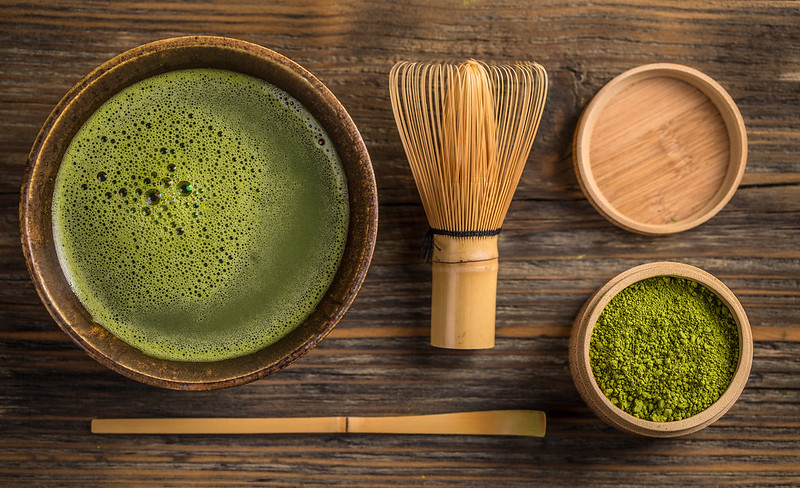
Know More About the Japanese Tea Ceremony
Also known as the Way of the Tea, the Japanese tea ceremony is the traditional method of preparing and drinking matcha, or powdered green tea. The ceremony is called sado (茶道) or chanoyu (茶の湯) in Japanese culture. The manner in which the event is performed is called otemae. The tea ceremony is highly influenced by the principles of Zen Buddhism.
Tea gatherings are classified as chaji (茶事) or chakai (茶会). A chakai is a simple hospitality event that includes thin tea, confections, and a light meal. A chaji is a formal gathering that includes a full course kaiseki meal followed by confections, thick tea, and then thin tea. A chaji ceremonial gathering lasts for at least four hours.
Origins
The earliest tea ceremony came to Japan in the 6th century as a significant part of Buddhist meditation. The first documented tea in Japan dates back to a Buddhist monk, Eichu, as he arrived from China in the 9th century. Eichu was believed to have served green tea personally tea to Emperor Saga in 819 while on an excursion in Karasaki.
At the end of the 12th century, another Buddhist monk named Eisai introduced tencha (tea preparation) to Japan. He brought with him seeds that yielded high quality tea leaves. During the Kamakura Shogunate, tea became a status symbol of the warrior class. During this time, tea tasting parties came into wide practice in Japan, regardless of society level. Many tea ceremony schools have evolved throughout the history of chado and are still active today.
Venue
Any room or space where the needed implements for tea preparation can be set and where the host can make tea in front of their seated guests may be used. An outdoor, picnic-style gathering is known as nodate (野点).
A chashitsu is a room specially built for tea ceremonies. It has a waiting area, tatami floors, a low ceiling, shoji (screens), an alcove for scrolls, a hearth built into the floor, and several entrances for guests and host.
Usucha and Koicha
There are two primary ways of preparing matcha: usucha (薄茶) and koicha (濃茶). Koicha is a rich, thick blend of matcha and hot water that uses about three times as much tea as usucha. To prepare usucha, hot water and matcha are whipped with a tea whisk, while koicha has to be kneaded to blend the huge amount of matcha with hot water.
Thin tea is usually served in individual bowls, while a bowl of thick tea is shared among a number of guests. The most crucial part of chaji is the preparation and drinking of the koicha, followed by the usucha. A chaji may also involve the serving of thin tea and confections–in effect, a chakai sandwiched in–for a more relaxed ending.
Elements
Chadogu (茶道具) refers, collectively, to tea equipment. A wide variety of chadogu designs fits every season and event. Tools used in the ceremony are usually handled with much care. They are cleaned very well before and after use. The Japanese culture values the ritual so much that some chadogu are handled only with gloved hands.
Chakin (茶巾). A small rectangular hemp cloth or linen to wipe the tea bowls.
Natsume (棗). A small lidded tea caddy that holds the tea for brewing.
Chawan (茶碗). A tea bowl. Chawans come in a wide range of styles and sizes. Shallow tea bowls are used in summer so that the tea cools easily, while deep bowls are popular in the winter.
Chasen (茶筅). Tea whisk to mix the hot water and powdered tea, usually made from a single piece of bamboo.
Chashaku (茶杓). A tea scoop, of bamboo, wood, or ivory, to transfer tea into the tea caddy.
The Ceremony
The Japanese tea ceremony varies from one school of thought to another, as well as with the time of day, season, venue, and other important factors. Guests usually arrive earlier than the appointed time and enter the waiting room, where they store coats and put on tabi (足袋) or traditional Japanese socks.
The guests then proceed to a stone basin where they wash their hands and rinse their mouths with water, continuing to the tea house. They then sit on the tatami in order of status. When everyone is seated, the host is alerted through a sound created by the closing of the door.
The chaji starts with the laying of a charcoal fire to heat the water. Guests are then served each course of food, followed by a sweet edible paper called kaishi. After the meal, guests take a break in the waiting area. When they are summoned back, they perform the cleansing ritual again and sit in their original positions.
The host performs the ritual of cleansing the utensils in front of the guests. The host exchanges bows with each guest receiving tea. The guest rotates the bowl (to avoid drinking from the front), takes a sip, and compliments the host. After a few sips, the guest then wipes clean the bowl’s rim and passes it to the next guest.
Check out this inside view of the KCP Tea Ceremony Session:
After everyone has taken their sip from the bowl, the host adds more charcoal to the fire and brings more confections and a smoking set to the tea room. The host prepares an individual bowl for each guest. After all the guests finish their tea, the host cleans the chadogu and at the same time allows guests to take a look at them. Items are treated with extreme care, as they may be priceless, irreplaceable antiques.


